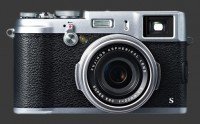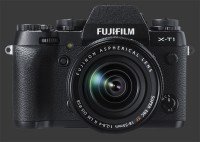Fujifilm X-T1 Review
Fujifilm X-T1 Performance - How well does it take pictures?
Performance starts with image quality, which is the criteria used as the foundation of our digital camera ratings. Ergonomic issues may get in the way, but in the end, image quality counts the most. For an ILC, image quality greatly depends on the lens used. While color, noise, exposure and dynamic-range are properties of a camera, distortion, vignetting and chromatic aberrations are properties of the lens. Sharpness and contrast depend on the weakest link. That is, a camera cannot capture more details than a lens lets through. Conversely, it is quite possible for a lens to transmit more details than a sensor can capture.

Image Noise & Details
The Fuji X-T1 produces images of exceptional quality, exceeding the quality of the almost all cropped-sensor DSLR throughout its range of ISO sensitivities, making it even comparable to some full-frame models. Image noise is inexistent all the way to ISO 3200 and becomes barely detectable at ISO 6400. ISO 12800 is almost the same and only at ISO 25600 do some details get affected by noise. Still, mid-size prints are possible at such high sensitivity.
The final expanded ISO of 51200 is actually usable for small prints. This signifies a new milestone for APS-C sensors! Small 4x6" prints are obviously noisy at that sensitivity but allow subjects to be recognized.
The unique X-Trans CMOS II sensor of the Fuji X-T1 is capable of extracting very fine details from scenery when combined with a sharp lens. Fuji offers excellent ones, including the Fujifilm Fujinon XF56mm F/1.2R
Fujifilm Fujinon XF56mm F/1.2R tested in pre-production form. A production Fujifilm Fujinon XF23mm F/1.4R
Fujifilm Fujinon XF23mm F/1.4R also delivered spectacular results.
Sharpness is controllable in 5 levels. Things start from a very soft to over-sharp, so each step is quite coarse. Default sharpness is just right, delivering crisp details without any artifacts. There 5 levels of noise-reduction too which are extremely close in output quality. Still, each level is more aggressive at higher sensitivities, so a setting of -1 delivers an optimal compromise between noise and details.

Color & White Balance
Color accuracy of the X-T1 is very good. Hues realistic with different Film Simulation modes mostly affecting saturation. The standard Provia film exaggerates saturation which can be improved by setting Color to -1. Alternately, using Astia film simulation provides a similar rendition of color.
Automatic White-Balance is quite dependable under typical conditions. It handles both natural and artificial lighting surprisingly well, only leaving the occasional yellow cast under artificial lighting. The Custom White-Balance option is there for difficult situations and is perfectly accurate.
Exposure
The Multi-Segment metering system of the X-T1 is extremely reliable and consistent. It is highly conservative which results in darker-than-usual images. It rarely blows anything but the smallest highlights, although it may not seem like it on the EVF and LCD because their dynamic-range is much more narrow than what this camera can capture.
Dynamic-Range of the X-T1 is spectacular when increased to 200% starting at ISO 400 or to 400% starting at ISO 800 which is possible all the way to all the way to 6400. This camera handles high-contrast scenes even better than most digital cameras, including top-of-the-line DSLRs.

Auto Focus
The Fuji X-T1 features a hybrid Phase-Detect and Contrast-Detect AF which debuted on the X100S
Fujifilm X100S. This camera exposes a 49-point AF system which uses both systems at each point to achieve fast autofocus speeds. These systems work together which make the camera appear more decisive.
Autofocus performance matches closely that of the X-E2 in both speed and sensitivity. Under good light it locks in between ¼ and ½s. It can take a tad longer on low-light. Low-contrast subjects slow autofocus a little more when it can take a full second to lock. It appears that Phase-Detect brings the focus within some tolerance and Contrast-Detect refines it. This shows up as back-and-forth movement of the lens towards the end the AF cycle but not at the start.
Continuous autofocus (AF-C) is reasonable in good light yet never manages to keep up in moderate-to-low lighting. It moves the lens to the approximate distance quickly but then spends a lot of time moving the lens back and forth to lock focus. This clearly too slow for moving subjects. Oddly, the X-E2 did much better in this regard.
The AF-L button performs focus on-demand in both autofocus and manual focus modes. It adjust focus further, AF-L must be released. Manual Focusing is done via a fly-by-wire ring at the front of current XF-mount lenses.

Speed
The Fuji X-T1 is generally quick and responsive. Dials change settings without delay and all buttons start their action immediately. Since the latter are quite flush with the camera body, it sometimes seems that buttons are unresponsive. When pressed fully though, this is not the case. Unfortunately, the menu system takes exception to this due to a fade-in effect which occurs while options and submenus appear.
Continuous shooting occurs at a maximum of 8 FPS which is comparable to high-end DSLRs but slower than several mirrorless models from Olympus and Sony. The buffer is capable of absorbing 47 JPEG images or 24 RAW in one burst while using a UHS-II memory card.
The following measurements characterize the performance of the Fuji X-T1:
- Power-On: 1s without sensor-cleaning. Good.
- Power-On to First-Shot: 1½ seconds. Average.
- Autofocus: ¼ - 1s, depending on the light. Highly variable but average.
- Shutter-lag: Immediate with just over ¼s blackout. Good.
- Shot-to-shot: 1s with AF. 3/4s with MF. Average.
- Playback: 3/4s to enter or exit. Slow.
- Power-Off: Normally under 1s but occasionally takes several seconds even with an empty buffer. Very slow.
- Video: 1s to start. Instant to stop. Slow.
The performance of the X-T1 is reasonable yet below par for a high-end offering. The shutter-lag is great yet the black-out is a little slower than expected. Autofocus speed ranges from very fast to downright slow. Phase-Detect AF is fast. However, the camera often needs to refine with Contrast-Detect before finally locking focus which can take a while. This definitely makes the X-T1 unsuitable for action photography except perhaps in the rather bright light.
Shot-to-shot speeds are decidedly average. Despite the camera being able to shoot continuously at 8 FPS, a noticeable delay occurs between shots when the shutter-release is pressed each time. Although entering and exiting Playback mode is slower than usual, only starting to record video is disappointingly slow. Powering off usually takes a reasonable second to happen but our X-T1 sometimes took up to 3 seconds without obvious reason. This is most likely a bug which we expect Fuji to fix via firmware.
The Fuji X-T1 is powered by a small proprietary Lithium-Ion battery which provides 350 shots-per-charge. This is about average and goes down quickly while reviewing images. Another battery is highly recommended not to run out unexpectedly.
Fujifilm X-T1 Conclusion

The Fuji X-T1 is the most advanced Fuji mirrorless yet. Its fusion of analog and digital controls goes beyond any previous offerings while its superb 2.4 megapixels EVF with 100% coverage and 0.77X magnification delivers a class-leading viewfinder experience which rivals highly-regarded optical ones.
As the first weather-sealed mirrorless which also includes dual control-dials plus dedicated dials for EC, ISO and Shutter-Speed, the Fuji X-T1 is squarely aimed at professional photographers. Its potential is yet to be fully realized due to the complete absence of weather-sealed X-mount lenses, something that Fuji intends to correct later this year.
The proven 16 megapixels X-Trans CMOS II sensor with built-in Phase-Detect autofocus is now paired with a revised EXR II processor which produces outstanding results. This is the first mirrorless to outperform the X-E1 when it comes to image-quality. Image-noise is extremely low with an excellent retention of details. Even when raising the ISO, noise-reduction is gentle enough to make usable prints at ultra-high sensitivities.
The APS-C sensor on the Fuji X-T1 requires no anti-alias filter and therefore takes advantage of the maximum sharpness a lens delivers. With a class-leading sensitivity of ISO 51200 and a superb dynamic-range, the Fuji X-T1 truly earns the highest rating among mirrorless cameras.
The metering system is excellent and Fuji's color-rendition is quite good. Automatic white-balance handles most types of lighting well too, leaving the occasional yellow cast when confronted with dim tungsten lighting. The X-T1 is naturally equipped with other white-balance settings to capture neutral colors in such conditions.
The performance of the X-T1 is generally solid. While shot-to-shot speeds are good, the new hybrid autofocus system is highly variable. It can lock focus very quickly yet slows down considerably in moderate light. The lack of a video mode causes this camera to miss the first second of action which is disappointing for videographers.
The only concerning issues with this Fuji camera have to do with its ergonomics. While the layout and number of controls is excellent, they are difficult to operate. This is exasperated when wearing gloves since both control-dials and all buttons are almost flush with the camera surface. Unlocked dials have relatively weak detents, as do aperture-rings on all current Fujinon lenses which makes this camera more accident-prone than most.
The end-result is that the Fuji X-T1 produces superior image-quality while being quite efficient to operate. At the same time, one must be keep an eye on camera settings more closely than usual. The new EVF is a giant leap forward in terms of experience which should greatly appeal those clinging to their DSLR for its OVF yet wishing for something smaller.
 |
Please Support Neocamera
All information on Neocamera is provided free of charge yet running this website is a huge endeavor. Purchases made via affiliate links found throughout the site help keep it running and up-to-date. There is no additional cost to you, so please consider buying via these links to our affilates:
Thank you for your support!
Fujifilm X-T1 Highlights

Sensor-Size: 24 x 16mm

Actual size when viewed at 100 DPI
| 16 Megapixels Mirrorless | ISO 100-51200 |
| Fujifilm X Mount 1.5X FLM | Shutter 1/4000-30s |
| 0.50" Built-in EVF 2.4 Megapixels (0.77X) | Full manual controls, including Manual Focus |
| Automatic Eye-Start sensor | Custom white-balance with 2 axis fine-tuning |
| 1 Axis Digital Level | Spot-Metering |
| Weatherproof down to -10C | Hot-Shoe |
| Built-in Dust Reduction | Stereo audio input |
| 8 FPS Drive, 47 Images | Lithium-Ion Battery |
| 1920x1080 @ 60 FPS Video Recording | Secure Digital Extended Capacity |
| 3" LCD 1 Megapixels |
Updates
2025.11.13

Best Gifts for Photographers in 2025 by Budget
The annual Neocamera Photography Gift Guide updated to 2025. Find great gifts for photographers with any price budget.
2025.07.07

Stellar Photo Recovery Review
Review of Stellar Photo Recovery V12. This Windows and MacOS software can recover photos and videos in a huge number of formats from memory cards, USB drives, SSDs and HHDs.
2025.05.14

Huion Kamvas 13 Gen 3 Review
In-Depth review of the Huion Kamvas 13 Gen 3 Pen Display Tablet for photographers and graphic artists.
2025.01.18

Fujifilm GFX 2025 Lens Roundup
Lens Review roundup of Fujifilm GFX Medium-Format lenses. Quality, performance and handling of the GF20-35mm F/4R WR, GF30mm F/3.5 Tilt-Shift and the GF55mm F/1.7.
2024.11.18

Best 2024 Photography Gifts for Every Budget
Great gifts for photographers and photo enthusiasts selected for every budget among the best products of 2024.
2024.08.07

Eye Protection Tips for Professional Photographers
The four main considerations for professional photographers regarding eyewear.
2024.07.14

Fujifilm X100VI Review
Flagship fixed-lens compact digital camera with a 40 MP sensor and Image-Stabilization, a first for the series. Retro design featuring dual control-dials, plus direct ISO, Shutter-Speed and EC dials. Its hybrid viewfinder can switch between EVF and OVF mode.
2024.05.09

Fujifilm GFX100 II Review
Flagship 102 Megapixels Medium-Format Mirrorless Digital Camera with 8-Stop 5-Axis IBIS, 8 FPS Drive, 8K Video and 400 MP Super-Resolution capture in a weatherproof and freezeproof body with dual control-dials and dual memory-card slots.
2024.04.03

Fujifilm X-T5 Review
Newest Fujifilm flagship boasting a 40 MP APS-C sensor, 5-axis IBIS with 7-stop efficiency, 15 FPS continuous drive, 6.2K Video capture, dual control-dials and dual SDXC UHS-II slots in a sturdy weatherproof and freezeproof body.
2023.11.20

Best Digital Cameras of 2023
Find out which are the Best Digital Cameras of 2023. All the new Mirrorless Digital Cameras from entry-level to high-end professional.
2023.07.10

Fujifilm X-H2 Review
40 Megapixels APS-C Hybrid Mirrorless Digital Camera with 7-stop IBIS. Fastest shutter ever and 8K video capture. Large builtin EVF with 0.8X magnification and 5.8 MP, plus an Eye-Start Sensor. Packed with features and large number of controls in a weatherproof and freezeproof body.
2023.05.07

Sony FE 20-70mm F/4G Review
Review of the unique Sony FE 20-70mm F/4G lens. The optical zoom of this lens spans ultra-wide-angle and medium focal-length coverage, making it one of the most versatile Full-Frame lenses on the market.











